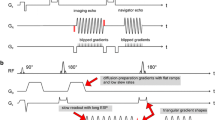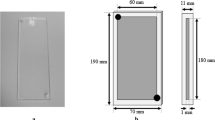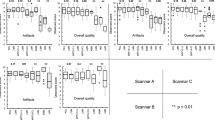Abstract
Objective
To reduce acoustic noise levels in T 1-weighted and proton-density-weighted turbo spin-echo (TSE) sequences, which typically reach acoustic noise levels up to 100 dB(A) in clinical practice.
Materials and methods
Five acoustic noise reduction strategies were combined: (1) gradient ramps and shapes were changed from trapezoidal to triangular, (2) variable-encoding-time imaging was implemented to relax the phase-encoding gradient timing, (3) RF pulses were adapted to avoid the need for reversing the polarity of the slice-rewinding gradient, (4) readout bandwidth was increased to provide more time for gradient activity on other axes, (5) the number of slices per TR was reduced to limit the total gradient activity per unit time. We evaluated the influence of each measure on the acoustic noise level, and conducted in vivo measurements on a healthy volunteer. Sound recordings were taken for comparison.
Results
An overall acoustic noise reduction of up to 16.8 dB(A) was obtained by the proposed strategies (1–4) and the acquisition of half the number of slices per TR only. Image quality in terms of SNR and CNR was found to be preserved.
Conclusions
The proposed measures in this study allowed a threefold reduction in the acoustic perception of T 1-weighted and proton-density-weighted TSE sequences compared to a standard TSE-acquisition. This could be achieved without visible degradation of image quality, showing the potential to improve patient comfort and scan acceptability.






Similar content being viewed by others
References
Hennig J, Nauerth A, Friedburg H (1986) RARE imaging: a fast imaging method for clinical MR. Magn Reson Med 3:823–833
Hajnal JV, Bryant DJ, Kasuboski L, Pattany PM, Decoene B, Lewis PD, Pennock JM, Oatridge A, Young IR, Bydder GM (1992) Use of fluid attenuated inversion recovery (flair) pulse sequences in MRI of the brain. J Comput Assist Tomogr 16:841–844
Hennel F (2001) Fast spin echo and fast gradient echo MRI with low acoustic noise. J Magn Reson Imaging 13:960–966
Hattori Y, Fukatsu H, Ishigaki T (2007) Measurement and evaluation of the acoustic noise of a 3 Tesla MR scanner. Nagoya J Med Sci 69:23–28
Mansfield P, Glover PM, Beaumont J (1998) Sound generation in gradient coil structures for MRI. Magn Reson Med 39:539–550
McJury M, Shellock FG (2000) Auditory noise associated with MR procedures: a review. J Magn Reson Imaging 12:37–45
Heismann B, Ott M, Grodzki D (2015) Sequence-based acoustic noise reduction of clinical MRI scans. Magn Reson Med 73:1104–1109
Moelker A, Maas RA, Vogel MW, Ouhlous M, Pattynama PM (2005) Importance of bone-conducted sound transmission on patient hearing in the MR scanner. J Magn Reson Imaging 22:163–169
Counter SA, Olofsson A, Borg E, Bjelke B, Haggstrom A, Grahn HF (2000) Analysis of magnetic resonance imaging acoustic noise generated by a 4.7 T experimental system. Acta Otolaryngol 120:739–743
Foster JR, Hall DA, Summerfield AQ, Palmer AR, Bowtell RW (2000) Sound-level measurements and calculations of safe noise dosage during EPI at 3 T. J Magn Reson Imaging 12:157–163
Committee on Environmental Health (1997) Noise: a hazard for the fetus and newborn. Pediatrics 100:724–727
Rabinowitz PM (2000) Noise-induced hearing loss. Am Fam Physician 61(2749–2756):2759–2760
Clark WW (1992) Hearing: the effects of noise. Otolaryngol Head Neck Surg 106:669–676
Quirk ME, Letendre AJ, Ciottone RA, Lingley JF (1989) Anxiety in patients undergoing MR imaging. Radiology 170:463–466
Edelstein WA, Hedeen RA, Mallozzi RP, El-Hamamsy SA, Ackermann RA, Havens TJ (2002) Making MRI quieter. Magn Reson Imaging 20:155–163
Goldman AM, Gossman WE, Friedlander PC (1989) Reduction of sound levels with antinoise in MR imaging. Radiology 173:549–550
McJury M, Stewart RW, Crawford D, Toma E (1997) The use of active noise control (ANC) to reduce acoustic noise generated during MRI scanning: some initial results. Magn Reson Imaging 15:319–322
Mansfield P, Glover P, Bowtell R (1994) Active acoustic screening: design principles for quiet gradient coils in MRI. Meas Sci Technol 5:1021
Mansfield P, Chapman BL, Bowtell R, Glover P, Coxon R, Harvey PR (1995) Active acoustic screening: reduction of noise in gradient coils by Lorentz force balancing. Magn Reson Med 33:276–281
Hennel F, Girard F, Loenneker T (1999) “Silent” MRI with soft gradient pulses. Magn Reson Med 42:6–10
Baker MA (2013) Reduction of MRI acoustic noise achieved by manipulation of scan parameters—a study using veterinary MR sequences. Radiography 19:11–16
Pierre EY, Grodzki D, Aandal G, Heismann B, Badve C, Gulani V, Sunshine JL, Schluchter M, Liu K, Griswold MA (2014) Parallel imaging-based reduction of acoustic noise for clinical magnetic resonance imaging. Invest Radiol 49:620–626
Feinberg DA (1997) VET imaging: magnetic resonance imaging with variable encoding time. Magn Reson Med 38:7–14
Hennig J (1988) Multiecho imaging sequences with low refocusing flip angles. J Magn Reson 78:397–407
Robson PM, Grant AK, Madhuranthakam AJ, Lattanzi R, Sodickson DK, McKenzie CA (2008) Comprehensive quantification of signal-to-noise ratio and g-factor for image-based and k-space-based parallel imaging reconstructions. Magn Reson Med 60:895–907
Griswold MA, Walsh D, Heidemann RM, Haase A, Jakob PM (2002) The use of an adaptive reconstruction for array coil sensitivity mapping and intensity normalization. In Proceedings of ISMRM, Honolulu, Hawaii, USA, p 2410
Robinson D, Whittle L (1960) The loudness of directional sound fields. Acta Acust United Acust 10:74–80
Dietrich O, Raya JG, Reeder SB, Reiser MF, Schoenberg SO (2007) Measurement of signal-to-noise ratios in MR images: influence of multichannel coils, parallel imaging, and reconstruction filters. J Magn Reson Imaging 26:375–385
Pruessmann KP, Weiger M, Scheidegger MB, Boesiger P (1999) SENSE: sensitivity encoding for fast MRI. Magn Reson Med 42:952–962
Griswold MA, Jakob PM, Heidemann RM, Nittka M, Jellus V, Wang J, Kiefer B, Haase A (2002) Generalized autocalibrating partially parallel acquisitions (GRAPPA). Magn Reson Med 47:1202–1210
Blaimer M, Gutberlet M, Kellman P, Breuer FA, Kostler H, Griswold MA (2009) Virtual coil concept for improved parallel MRI employing conjugate symmetric signals. Magn Reson Med 61:93–102
Wiggins GC, Polimeni JR, Potthast A, Schmitt M, Alagappan V, Wald LL (2009) 96-Channel receive-only head coil for 3 Tesla: design optimization and evaluation. Magn Reson Med 62:754–762
Norris DG, Koopmans PJ, Boyacioglu R, Barth M (2011) Power independent of number of slices (PINS) radiofrequency pulses for low-power simultaneous multislice excitation. Magn Reson Med 66:1234–1240
Breuer FA, Blaimer M, Heidemann RM, Mueller MF, Griswold MA, Jakob PM (2005) Controlled aliasing in parallel imaging results in higher acceleration (CAIPIRINHA) for multi-slice imaging. Magn Reson Med 53:684–691
Author information
Authors and Affiliations
Corresponding author
Ethics declarations
Conflict of interest
Drs. Grodzki and Heismann are employees of Siemens Healthcare. All other authors declare that they have no conflict of interest.
Ethical standards
Informed consent was obtained from all volunteers included in the study.
Electronic supplementary material
Below is the link to the electronic supplementary material.
Rights and permissions
About this article
Cite this article
Ott, M., Blaimer, M., Breuer, F. et al. Acoustic noise reduction in T 1- and proton-density-weighted turbo spin-echo imaging. Magn Reson Mater Phy 29, 5–15 (2016). https://doi.org/10.1007/s10334-015-0502-7
Received:
Revised:
Accepted:
Published:
Issue Date:
DOI: https://doi.org/10.1007/s10334-015-0502-7




